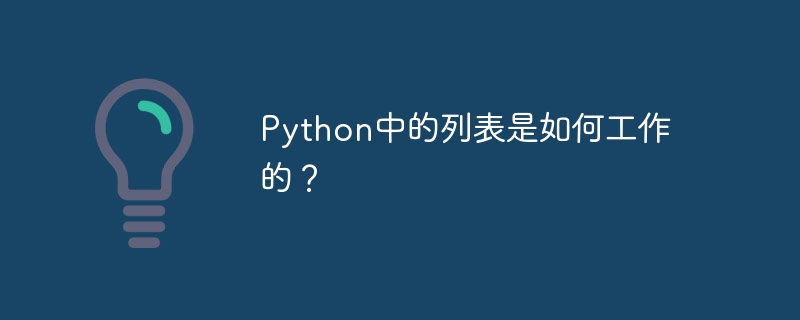

List in Python is a very commonly used data structure. It can be used to store a series of elements and allows various operations, such as adding, deleting, modifying and accessing elements. In this article, we'll detail how lists work in Python, along with concrete code examples.
A list in Python is an ordered variable data structure that can contain elements of various types, such as integers, floating point numbers, strings, etc. Creating a list is very simple, just use square brackets to enclose the elements and separate them with commas. Here is an example of creating a list:
fruits = ['apple', 'banana', 'orange', 'grape']
In the above example, we created a list containing four fruits. Elements in the list can be accessed by index, which starts at 0. For example, to access the first element in a list, you would use the following code:
first_fruit = fruits[0] print(first_fruit) # 输出:apple
Lists also provide many methods to manipulate elements. For example, you can use the append() method to add a new element to the end of the list, as shown below:
fruits.append('pineapple')
print(fruits) # 输出:['apple', 'banana', 'orange', 'grape', 'pineapple']You can also use the insert() method to insert a new element at a specified position, as shown below:
fruits.insert(2, 'lemon') print(fruits) # 输出:['apple', 'banana', 'lemon', 'orange', 'grape', 'pineapple']
In addition to adding elements, you can also use the remove() method to remove specified elements from the list, as shown below:
fruits.remove('orange')
print(fruits) # 输出:['apple', 'banana', 'lemon', 'grape', 'pineapple']If you want to delete the last element in the list, you can use the pop() method , as shown below:
fruits.pop() print(fruits) # 输出:['apple', 'banana', 'lemon', 'grape']
Lists also support slicing operations, which can be used to obtain part of the list. For example, to get the first three elements in a list, you can use the following code:
first_three = fruits[:3] print(first_three) # 输出:['apple', 'banana', 'lemon']
There are many other methods and operations on lists, such as finding the length of the list, determining whether an element is in the list, sorting, etc. You can learn more about using lists by consulting the official Python documentation.
To summarize, a list in Python is a very powerful and flexible data structure that can be used to store various types of elements and provides many methods to manipulate elements. By mastering the use of lists, we can handle various problems more efficiently and improve programming efficiency.
This article provides a brief introduction to lists in Python and gives some specific code examples. I hope this information helps you better understand and use lists in Python.
The above is the detailed content of How do lists work in Python?. For more information, please follow other related articles on the PHP Chinese website!




